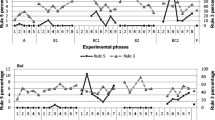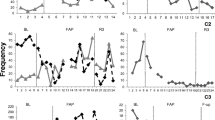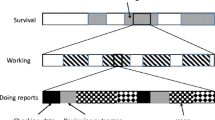Abstract
Clinical behavior analysis often targets the shaping of clients’ functional interpretations of/or rules about his own behavior. These are referred to as clinically relevant behavior 3 (CRB3) in functional analytic psychotherapy (FAP). We suggest that CRB3s should be seen as contingency-specifying stimuli (CSS), due to the their ability to change the function of stimuli—including descriptions of variables involved in the client’s behavioral problems as well as descriptions of variables associated with improvement or therapeutic change. This paper discusses the role of rule-governed behavior in FAP and the processes of shaping client interpretations of his or her behavior, and proposes that this may be an overlooked and important mechanism of change in FAP. To shape CRB3 in FAP, the therapist describes CSSs related to the therapy relationship that are consistent with the client’s social environment, and reinforces improvements of the client’s following his or her own newly shaped CSS descriptions during the session.
Similar content being viewed by others
References
Beck, J. S. (1995). Cognitive therapy: basics and beyond. New York: Guilford.
Beck, A. T., Rush, A.J., Shaw, B. F., & Emery, G. (1979). Cognitive therapy of depression. New York: Guilford Press.
Blakely, E., & Schlinger, H. (1987). Rules: function-altering contingency-specifying stimuli. The Behavior Analyst, 10, 183–187.
Catania, A. C. (2003). Verbal governance, verbal shaping and attention to verbal stimuli. In K. A. Lattal & P. N. Chase (Eds.), Behavior theory and philosophy (pp. 301–321). New York: Plenum Publishers.
Catania, A. C., Matthews, B. A., & Shimoff, E. (1982). Instruct versus shaped human verbal behavior: Interactions with nonverbal responding. Journal of the Experimental Analysis of Behavior, 38(3), 233–248.
Dougher, M. J. (1993). Introduction. Behavior Analyst, 16, 269–270.
Dougher, M. J. (1994). Introduction. Behavior Analyst, 17, 287–288.
Dougher, M. J. (2000). Clinical behavior analysis. Reno, NY: Context Press.
Ferster, C. B. (1979). Psychotherapy from the standpoint of a behaviorist. In J. D. Keehn (Ed.), Psychopathology in Animals: Research and Clinical Implications (pp. 279–303). New York: Academic Press.
Hayes, S. C., Kohlenberg, B. S., & Melancon, S. M. (1989). Avoiding and altering rule-control as a strategy of clinical intervention. In S. C. Hayes (Ed.), Rule-governed behavior: cognition, contingencies, and instructional control (pp. 359–385). New York: Plenum.
Hayes, S. C., Zettle, R. D., & Rosenfarb, I. (1989). Rule following. In S. C. Hayes (Ed.), Rule-governed behavior: Cognition, contingencies, and instructional control (pp. 191–220). New York: Plenum.
Kanter, J. W., Callaghan, G. M., Landes, S. J., Bush, A. M., & Brown, K. R. (2004). Behavior analytic conceptualization and the treatment of depression: traditional models and recent advances. The Behavior Analyst Today, 5(3), 255–274.
Kohlenberg, R. J., & Tsai, M. (1991). Functional analytic psychotherapy: Creating intense and curative therapeutic relationships. New York: Plenum Press.
Kohlenberg, R. J., Tsai, M., & Kanter, J. W. (2009). What is functional analytic psychotherapy? In R. J. Kohlenberg, J. W. Kanter, B. Kohlenbrg, W. C. Follette, & G. Callaghan (Eds.), A guide to functional analytic psychotherapy: Awareness, courage, love, and behaviorism (pp. 1–19). New York: Springer.
Lerman, D. C., & Vorndran, C. M. (2002). On the status of knowledge for using punishment: implications for treating behavior disorders. Journal of the Applied Analysis of Behavior, 35(4), 431–464.
McSweeney, F. K., & Weatherly, J. N. (1998). Habituation to the reinforcer may contribute to multiple-schedule behavioral contrast. Journal of the Experimental Analysis of Behavior, 69(2), 199–221.
Saltzman, I. J. (1951). Delay of reward and human verbal learning. Journal of the Experimental Psychology, 41, 437–439.
Salzinger, K. (1998). The verbal operant: cause and/or effect. The Analysis of Verbal Behavior, 15, 135–137.
Schlinger, H. (1990). A reply to behavior analysts writing about rules and rule-governed behavior. The Analysis of Verbal Behavior, 8, 77–82.
Schlinger, H. (1993). Separating discriminative and function-altering effects of verbal stimuli. The Behavior Analyst, 16, 9–23.
Skinner, B. F. (1992). Verbal behavior. Acton, MA: Copley Publishing Group (Original work published 1957.).
Skinner, B. F. (1968). Science and human behavior. New York: Free Press/Collier Macmillan (Original work published 1953.).
Tarbox, J., & Hayes, L. P. (2005). Verbal behavior and contrast in human subjects. Psychological Record, 55, 419–437.
Tsai, M., Kohlenberg, R. J., Kanter, J. W., & Waltz, J. (2009) Therapeutic technique: the five rules. In R. J. Kohlenberg, J. W. Kanter, B. Kohlenbrg, W. C. Follette, & G. Callaghan (Eds.), A guide to functional analytic psychotherapy: awareness, courage, love, and behaviorism (pp. 61–102). New York: Springer.
Zamignani, D. R., & Meyer, S. B. (2011). Comportamentos verbais do terapeuta no sistema multidimensional para a categor-ização de comportamentos na interação terapêutica (SiMCCIT) [Therapist verbal behavior in the multidimensional system for categorization of behaviors in therapeutic interaction (SiMCCIT)]. Perspectivas em Análise do Comportamento, 2, 25–45.
Author information
Authors and Affiliations
Corresponding author
Additional information
Manuscript preparation was supported by a fellowship from Coordenação de Aperfeiçoamento de Pessoal de Nível Superior (CAPES) awarded to the first author.
We express our gratitude to Dr. Jonathan Kanter, from University of Wisconsin-Milwaukee, for his thorough revisions and encouragement to publish this manuscript.
Rights and permissions
About this article
Cite this article
Abreu, P.R., Costa Hübner, M.M. & Lucchese, F. The Role of Shaping the Client’s Interpretations in Functional Analytic Psychotherapy. Analysis Verbal Behav 28, 151–157 (2012). https://doi.org/10.1007/BF03393117
Published:
Issue Date:
DOI: https://doi.org/10.1007/BF03393117




